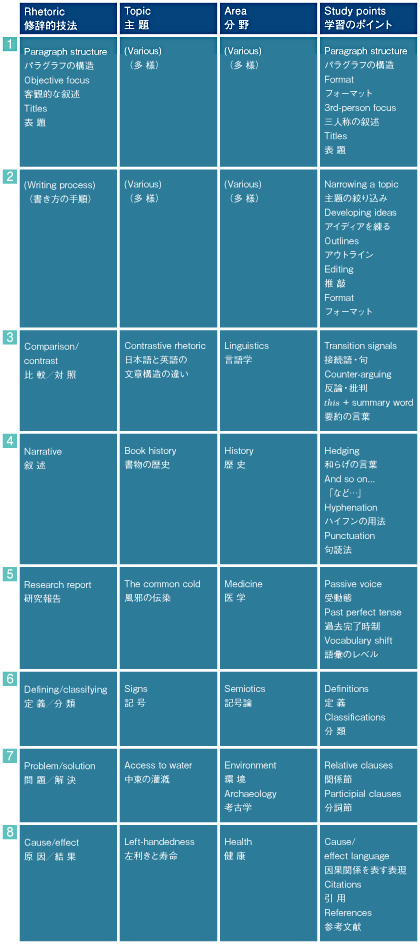First Moves
「英語が上手になりたい」というほとんど強迫観念に近い思いが日本人の心から離れない。その裏には、言うまでもなく、「英語が下手だ」という自意識が抜きがたく存在する。
そこで、なぜ英語が下手なのかと自問するならば、特に大学レベルで考えた場合、問題は主に3つある。第一は、基礎的英文法の知識が十分に学習されているとしても、それが実際に使いこなせない。英語教育歴6年という高等学校卒業者でも、相当数の人は動詞現在形三人称単数のsさえ完全に使いこなすことができない。第二に、いわゆる「日常あるいは旅の英会話」というものと、知的・論理的議論というものとの間にあまりにもギャップがあること。市井の英会話学校で学ぶレベルの流暢さは、大学ではほとんど知的に無内容であるかに響いてしまう。学ぶところの表現と、表現すべき内容とが齟齬をきたすのである。第三の問題は、そもそも母語である日本語できちんとした論理的文章を書く訓練を受けた経験がほとんどないという驚くべき現実がある。論理的文章を書くことができないということは、論理的にまず発想し、筋道を立てて主題を整理し、それを他人に分かるように順序良く正確に表現することができないということに他ならない。書くことができなければ、論理的に話すことができないのは事の道理というものだろう。
かくして、特に大学レベルで英語が上手になるためには、なにを学びなにをすべきかと考えるならば、まずは英語を通じて論理的文章作成法を学ぶに如くはなかろうというのがわれわれの結論である。そしてこれは通常「アカデミック・ライティング」と呼ばれるものに他ならない。そこには、基礎的な文法を確認して体得するいわば「文法実技」はもちろんのこと、非人称的な構文を主体とした表現、そのような「フォーマルな」文体に応じた語彙の選択、さらに文章の不分明を読み手の責任に転嫁するのではなく、あくまで意味の伝達は書き手の責任であるとする英語圏文化の大前提を説く異文化理解の問題も含まれる。そればかりではない。論理的思考の訓練への導入としての「アカデミック・ライティング」は、昨今問題となっている「学力低下」現象に対する具体的な対処法として、その一助となるものと信ずる。
本書 First Moves: An Introduction to Academic Writing in English は、こうした現状分析に基づいて企画・作成されたものである。日本でも海外でも、本格的な内容の文章をそれに相応しいレベルの英語で書く場合には、客観的で、形式に則った、論理的に構成された英文を書くことが当然求められる。本書は、そうした文章を書く技術を磨きたいと思う人なら、大学生にかぎらず誰でも参照することができるよう意図したものである。
本書のタイトル First Moves は、チェスの「最初の一手」(first moves)から得ている。このタイトルには2つの意味が込められている。まず、論理的作文は、チェスのように知的な活動であり、複雑なルールがあり、綿密な注意と戦略を必要とするということ。もう一つは、書き方の学習は、チェスのゲームと同様に、最初の一手が極めて重要だということであり、その最初の一手によって残りの成否が決まるといってもいいだろう。緻密にして客観的かつ論理的な英語の文章を書くために、読者が複雑で長い道のりへと力強い一歩を踏み出すことができるよう誘(いざな)うのが本書の目的である。そうした文章を書く技術は、大学では必須の技術だが、もちろんそれ以外の分野でも、極めて必要性の高い技術であることはいうまでもないだろう。
誰でも経験するように、「最初の一手」(first moves)は恐ろしく難儀である。その便宜にと、本書の各章にはモデル文が用意されていて、読者はこれから書くことになる文章の、論の進め方、展開の枠組等をここから具体的に学ぶことが出来るようになっている。しかし、文章の主題・トピックは特に設定されていない。それは読者が自分の関心の中から選ぶのである。これがいわゆる「和文英訳」的英作文と、英語で発想をしてゆく本書の「アカデミック・ライティング」とが本質的に異なるところである。読者は、モデル読解文で使われている論理的構成を自分の論文作成に応用し、語法練習の部分で学んだ言語表現をできるだけ取り入れることで、より明確で、正確で、効果的に意味を伝えることのできる文章を書くことができるようになるはずである。そしてこの段取りが、「思考」と呼ばれる作業に限りなく近いものであることは言うまでもなかろう。
各章の構成は、モデル文読解の便宜を図るべくボキャブラリーの確認等を行う[A]「準備」(Preparation)セクション、そして要となる[B]「モデル文」(Reading
Passage)とそれに関する読解問題、[C]モデル文の論理的構造を解説する「論理構造」(Logical Structure) セクション、[D]語法等を扱う(Language
Work)、そして最後に[E]作文の実践となっている。都合8章に掲げられるモデル文は、すべて等しく論理的構成により特徴づけられるが、内容と文体において多様性を持たせてある。
われわれは、大学生ばかりでなく、論理的に明晰で知的に洗練された英語を書きそして話すことを志す多くの人々が、本書を手にすることを願ってやまない。
本書は東京大学教養学部英語部会の企画立案に基づくが、執筆に際しては部会構成員であるポール・ロシター教授がこれを主に行い、企画制作委員会は随時助言等を通じて支援した。出版に際しては、東京大学出版会の後藤健介氏のお世話になった。記してお礼申し上げる。
東京大学教養学部英語部会
アカデミック・ライティング企画制作委員会
委員長 高田康成
When we write, we can do so in a wide variety of styles. If you write a poem, for example, the style you use will be different from the style you use when you write a letter to a close friend or a member of your family. This difference in style will be visible in many ways: you will use different kinds of words, you will make different choices about what grammar to use - even the appearance of the text on the page will be very different.
This book is an introduction to the academic style of writing - that is, the style of writing used in universities to write about serious topics, whether in the sciences or the humanities. A scientist may wish to report some research, a philosopher may wish to put forward an argument, a sociologist may wish to describe and analyse a tendency in society, but all of them will be using a variety of the academic style.
Of course, if you look at writing by professional scientists, philosophers, and sociologists - or by academic writers in any field - you will be able to see many differences between their texts; a philosopher's vocabulary will be very different from that of a physicist, for example. Nevertheless, despite these differences, there will be some large similarities. In academic writing, you will generally find that
- there is an objective, third-person focus in the writing (that is, the writer focuses on some non-personal kind of knowledge of the world rather than on his or her own experience).
- the writing is logically organised, and the writer takes care to make this logical organisation clear to the reader.
- as a result of this focus on objectivity and logic, the style is formal, rather than informal.
This book begins by introducing some basic features of the academic style. Then, in each of the later chapters, you will read a passage in which the three stylistic features mentioned above can be seen. After studying both the logical structure and the language of the Reading Passage, you will be asked to write a short essay (about 300-400 words long) on a topic of your own choice. When you write, you will, of course, be trying to express your own ideas about your topic, but you will also be practising the basics of the academic style. That is,
- you will practise maintaining a third-person, objective perspective.
- you will practise showing your logical organisation clearly in your text.
- you will practise writing which is formal in style.
The Reading Passages in the book are not, in fact, taken from academic books or articles at the most advanced level, but from a more popular kind of writing whose aim is to explain important ideas to the general public outside the university. The reason for choosing these kinds of texts is that you are at the beginning of your study of academic writing; it would be unfair to ask a first-year student who wishes to study literature, for example, to read a very advanced, technical text about physics, just as it would be unreasonable to ask a student who wishes to major in physical science to read a highly sophisticated text about literary theory. Instead, both the science-oriented and the humanities-oriented texts are designed to be accessible and interesting to both science and humanities students.
Nevertheless, although the texts are intended to be accessible to readers who are not yet specialists, they do show many features of specialist academic writing. They are about serious topics worthy of academic study, and they clearly show the three stylistic features mentioned above: objective focus, logical organisation, and formal style. Analysing these texts, and using them as models for your own writing, will therefore provide you with a good foundation in the academic style. Later, as you advance further in your studies, you will find out more about the specific ways in which English is used in your own field; then you will be able to build on the foundations you have laid down while working with this book, until you are able to write a full-length academic paper in your own subject.
How the Chapters Are Organised
Apart from the first two introductory chapters, all the chapters have a similar structure, consisting of five main parts:
- Preparation. An introduction to the topic and to relevant vocabulary.
- Reading. A Reading Passage, with comprehension questions. The Reading Passages have been chosen as examples of typical kinds of logical structure which can be found in academic writing.
- Logical Structure. An analysis of the logical structure of the Reading Passage; this structure will provide a framework for your own writing at the end of the chapter.
- Language Work. The study and practice of some useful language from the Reading Passage. Some of this work is concerned with grammar. The aim, however, is not to study grammar in a purely formal way, but to understand more deeply when and why you can use these kinds of grammar in order to express your ideas more clearly. These exercises will help you both to improve your grammatical accuracy, and to understand better how to use that grammar in order to communicate your ideas.
- Writing. A writing assignment, in which you are asked to
write a short essay on a serious topic of your choice (preferably
related to
your major). In your writing, you will use the logical structure you
found in the Reading Passage as a framework; and you should also
try
to use the language you have practised in the Language Work
exercises in order to make your writing clearer, more accurate, and more efficient.
There are two internationally accepted ways of spelling English: American spelling (for example, "organize," "color," "center," "traveling") and British spelling (for example, "organise," "colour," "centre," "travelling"); the "British" system is in fact used not only in the United Kingdom, but in many other parts of the world as well. The explanations in this book use the British system since the main author is British; in Reading Passages which have been taken from American sources, however, the American spelling has been preserved. This has been done because it is important to realise that English has varieties, and that you have a choice. It does not matter which system you choose to use; the important thing is to use one of them consistently. Thus, it is equally good if you write "his favorite color" (US) or "his favourite colour" (UK); avoid writing "his favorite colour," however. In reality, this difference does not affect a large number of words, so it does not create much difficulty. If you are in doubt about how to spell a word, consult a good dictionary which gives information about both ways of spelling.


